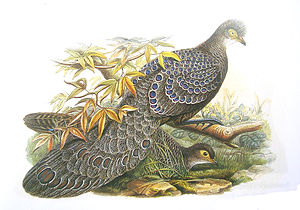Gray peacock pheasant
| Gray peacock pheasant | ||||||||||
|---|---|---|---|---|---|---|---|---|---|---|

Gray peacock pheasant ( Polyplectron bicalcaratum ) |
||||||||||
| Systematics | ||||||||||
|
||||||||||
| Scientific name | ||||||||||
| Polyplectron bicalcaratum | ||||||||||
| ( Linnaeus , 1758) |
The gray peacock pheasant ( Polyplectron bicalcaratum ), also called northern mirror peacock , is a species from the pheasant-like family . In contrast to other representatives of the genus of the peacock pheasant , this species is widespread and common. This species is the only representative of its genus in its range.
Appearance
Gray peacock pheasants have a wing length of 17.5 (females) to 24 centimeters (males). The sexual dimorphism is very pronounced in the length of the tail. In males it is 35 to 40 centimeters. Females, on the other hand, have a tail length of 23 to 25.5 centimeters.
The body plumage in the male appears predominantly gray to greyish. Females, on the other hand, have a brownish plumage color. Both sexes have dark, iridescent eye spots on their backs and wings. The male has a feather hood on the top of his head, which is often erect and then points forward. The male's tail is rounded and has large, iridescent eye spots.
The male's voice can be heard frequently. The characteristic, loud whistle of the species is onomatopoeically described as "trew-tree" or "taa-pwi". The male also repeatedly calls out a rough “putta”. The call gets faster and faster with increasing repetition and can usually be heard for several minutes.
There is a risk of confusion with the brown peacock pheasant , a species widespread in Vietnam. However, its plumage is dark gray and the featherless parts of the face are reddish in color.
Distribution area and habitat
The northern peacock pheasant occurs from the extreme eastern border area of India via Burma to the southeast of Indonesia. The gray peacock pheasant has the largest distribution area within the genus of the mirror peacock. The peacock pheasants from the Chinese island of Hainan , formerly regarded as a subspecies ( Polyplectron bicalcaratum katsumatae ) of the gray peacock pheasant, are now classified as a separate species ( Polyplectron katsumatae ).
Basically, the gray peacock pheasant is a bird whose occurrence is limited to the lowlands and forests at the foot of mountains. Most of the deposits are in regions no higher than 610 meters above sea level . But there are also reports that the gray peacock pheasant has been observed up to 1,800 meters. Between 1.5 and 3.7 individuals live in suitable habitats per square kilometer.
Gray peacock pheasants are particularly common in the thicket found along rivers. His habitats also include dense, evergreen forest, where a dense undergrowth of shrubs, shrubs and bamboo allows him to lead his hidden life. The ornithologist Paul Johnsgard describes a rice field on a slope as the ideal habitat for this type of peacock pheasant, which remained uncultivated for three or four years and on which a dense vegetation of young trees, shrubs and creepers has now formed.
Way of life
Gray peacock pheasants eat grain, berries, seeds, wild figs and plums, and insects such as termites. In search of food, they move very quietly and unobtrusively through the undergrowth. The scratching movements with which they scratch for food are also carried out very calmly.
The gray peacock pheasant is usually found in pairs or, at best, small family groups. It is uncertain whether these peacock pheasants are territorial birds. Presumably, however, one couple each populates a territory.
Like all peacock pheasants, the gray peacock pheasant shows extensive courtship behavior in which the male demonstrates his magnificent plumage in front of the female. To do this, the tail feathers are raised and raised. The wings are spread wide so that the iridescent eye patches are presented to the female.
As with other peacock pheasants, the clutch consists of only one or two eggs. However, the female is able to lay and incubate clutches several times in a row. Females kept in captivity have laid between 8 and 14 eggs annually. The eggs are only incubated by the female. However, the male stays nearby. Young birds follow the mother and seek shelter under her tail.
swell
Individual evidence
- ^ Johnsgard, p. 316
- ↑ J. Chang, B. Wang, Y.-Y. Zhang, Y. Liu, W. Liang, J.-Ch. Wang, H.-T. Shi, W.-B. Su & Z.-W. Zhang: Molecular Evidence for Species Status of the Endangered Hainan Peacock Pheasant. In Zoological Science , Vol. 25, No. 1, pp. 30-35, 2008. doi : 10.2108 / zsj.25.30
- ↑ a b Johnsgard, p. 317
- ^ Johnsgard, p. 318
- ↑ Johnsgard, p. 319
literature
- Paul Johnsgard: Pheasants of the world - Biology and natural history. Smithsonian Institution Press, Washington 1999, ISBN 1-84037-129-3
Web links
- Videos, photos and sound recordings for Polyplectron bicalcaratum in the Internet Bird Collection
- Polyplectron bicalcaratum inthe IUCN 2013 Red List of Threatened Species . Listed by: BirdLife International, 2013. Retrieved February 2, 2014.
